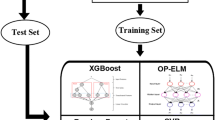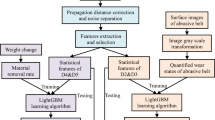Abstract
With outstanding material removal ability and high finish quality, robotic belt grinding has great advantages in processing difficult-to-machine materials like nickel-based superalloys. Tool wear is a severe problem in such grinding processes; thus, detection of tool wear is critical to precision finishing of a surface profile. This work proposes a novel acoustic signal-based detection method that combines a random forest (RF) classifier and a multiple linear regression (MLR) model to detect different wear periods and evaluate the remaining grinding ability for robotic belt grinding of nickel-based superalloys. The correlation between grinding sound and belt conditions is established through experimental studies and signal analysis. Through mapping the acoustic features of grinding sound and conditions of grinding belts, the RF classifier and the MLR model are trained and applied in prediction of grinding belt conditions. The total prediction accuracy of RF classifier for distinguishing different wear periods is over 94%, and the mean absolute percentage error of MLR model for evaluating the grinding ability in accelerated wear period is less than 9%. The online detection method can be used as a basis for adaptive control of grinding parameters to achieve precision profile finishing.
Similar content being viewed by others
References
Ezugwu EO, Bonney J, Yamane Y (2003) An overview of the machinability of aeroengine alloys. J Mater Process Technol 134:233–253 https://www.sciencedirect.com/science/article/pii/S0924013602010427?via%3Dihub
Ezugwu EO (2005) Key improvements in the machining of difficult-to-cut aerospace superalloys. Int J Mach Tools Manuf 45(12–13):1353–1367 https://www.sciencedirect.com/science/article/pii/S0890695505000544
Huang H, Gong ZM, Chen XQ, Zhou LB (2003) SMART robotic system for 3D profile turbine vane repair. Int J Adv Manuf Technol, ISSN 0268-3768 21(4):275–283. https://doi.org/10.1007/s001700300032
Han XS, Wu TY (2013) Analysis of acoustic emission in precision and high-efficiency grinding technology. Int J Adv Manuf Technol 67(9):1997–2006. https://doi.org/10.1007/s00170-012-4626-x
Blunt L, Ebdon S (1996) The application of three-dimensional surface measurement techniques to characterizing grinding wheel topography. Int J Mach Tools Manuf 36(11):1207–1226. https://doi.org/10.1016/0890-6955(96)00041-7
Fan KC, Lee MZ, Mou JI (2002) On-line non-contact system for grinding wheel wear measurement. Int J Adv Manuf Technol 19(1):14–22. https://doi.org/10.1007/PL00003964
Inasaki I (1999) Sensor fusion for monitoring and controlling grinding processes. Int J Adv Manuf Technol 15(10):730–736. https://doi.org/10.1007/s001700050125
Chen XQ, Li HZ (2009) Development of a tool wear observer model for online tool condition monitoring and control in machining nickel-based alloys. Int J Adv Manuf Technol 45:786–800. https://doi.org/10.1007/s00170-009-2003-1
Lachance S, Warkentin A, Bauer R (2003) Development of an automated system for measuring grinding wheel wear flats. J Manuf Syst 22(2):130–135. https://doi.org/10.1016/S0278-6125(03)90010-0
Salgado DR, Alonso FJ (2007) An approach based on current and sound signals for in-process tool wear monitoring. Int J Mach Tools Manuf 47:2140–2152. https://doi.org/10.1016/j.ijmachtools.2007.04.013
Shi D, Gindy NN (2007) Tool wear predictive model based on least squares support vector machines. Mech Syst Signal Process 21:1799–1814. https://doi.org/10.1016/j.ymssp.2006.07.016
Wang L, Gao RX (2006) Condition monitoring and control for intelligent manufacturing. Springer Series in Advanced Manufacturing, https://link.springer.com/book/10.1007%2F1-84628-269-1
Sun J, Hong GS, Wong YS, Raghman M, Wang ZG (2006) Effective training data selection in tool condition monitoring system. Int J Mach Tools Manuf 43(6):218–224. https://doi.org/10.1016/j.ijmachtools.2005.04.005
Schafrick R, Sprague R (2004) The saga of gas turbine material. Adv Mater Process 162(3):33–36 4:28-30
Weber H, Loladze TN (1986) Grundlagen des Spanens. VEB Verlag Technik, Berlin
Song S, Chen HB, Lin T, Wu D, Chen SB (2016) Penetration state recognition based on the double-soundsources characteristic of VPPAW and hidden Markov Model. J Mater Process Technol 234:33–44. https://doi.org/10.1016/j.jmatprotec.2016.03.002
Zhu KP (2009) Wavelet analysis of sensor signals for tool condition monitoring: a review and some new results. Int J Mach Tools Manuf 49:537–553. https://doi.org/10.1016/j.ijmachtools.2009.02.003
Breiman L (2001) Random forests. Machine Learning Journal 45(1):5–32. https://doi.org/10.1023/A:1010933404324
Kleinberg E (2000) On the algorithmic implementation of stochastic discrimination. IEEE Trans Pattern Anal Mach Intell 22(5):473–490. https://doi.org/10.1109/34.857004
James G, Witten D, Hastie T, Tibshirani R (2013) An introduction to statistical learning. Springer, New York, pp 316–321
Powers DMW (2011) Evaluation: from precision, recall and F-measure to ROC, informedness, markedness & correlation. J Mach Learn Technol 2(1):37–63
Yan X, Su XG (2009) Linear regression analysis: theory and computing. World Scientific, pp. 1–2. https://www.worldscientific.com/worldscibooks/10.1142/6986
Acknowledgements
The authors wish to acknowledge the Grinding Laboratory, 3M (Shanghai, China), for its support in conducting grinding experiments.
Author information
Authors and Affiliations
Corresponding author
Rights and permissions
About this article
Cite this article
Chen, J., Chen, H., Xu, J. et al. Acoustic signal-based tool condition monitoring in belt grinding of nickel-based superalloys using RF classifier and MLR algorithm. Int J Adv Manuf Technol 98, 859–872 (2018). https://doi.org/10.1007/s00170-018-2270-9
Received:
Accepted:
Published:
Issue Date:
DOI: https://doi.org/10.1007/s00170-018-2270-9




